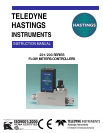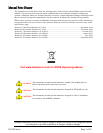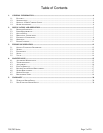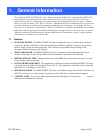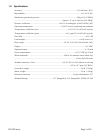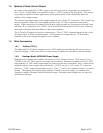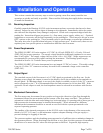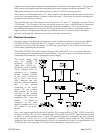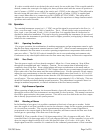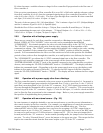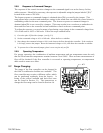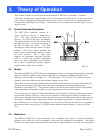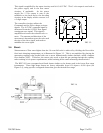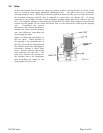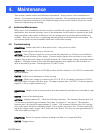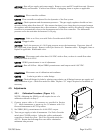201/203 Series Page 9 of 20
If a valve override switch is not desired, the unit is ready for use at this time. If the override switch is
desired, connect the center pin of a single pole, three-position switch with the center off position to
pin 8. Connect +15VDC to one end of the switch, and -15VDC to the other end. This will result in
the valve being full open when +15VDC is supplied to pin 8, off when -15VDC is supplied and
auto-control when there is no connection to pin 8 (OPEN-AUTO-CLOSE). This setup will be
adequate for most purposes, but there will be a small delay for capacitors to charge between switch
operation and control override.
2.6. Operation
The standard instrument output is a 0 - 5 VDC out and the signal is proportional to the flow i.e., 0
volts = zero flow and 5 volts = 100% of rated flow. The 4 - 20 mA option is also proportional to
flow, 4 mA = zero flow and 20 mA = 100% of rated flow. It is suggested that all connections be
checked for leaks after installation. This can be done by pressurizing the instrument (do not exceed
500 psig unless the instrument is specifically rated for higher pressures) and applying a diluted soap
solution to the connections.
2.6.1. Operating Conditions
For proper operation, the combination of ambient temperature and gas temperature must be such
that the flow meter temperature remains between 0 and 50°C. (Most accurate measurement of flow
will be obtained if the flow meter is zeroed at operating temperature as temperature shifts result in
some zero offset.) The 201/203 series is intended for use in non-condensing environments only.
Condensate or any other liquids which enter the flow meter may destroy its electronic components.
2.6.2. Zero Check
Turn the power supply on if not already energized. Allow for a 1 hour warm-up. Stop all flow
through the instrument and wait 2 minutes. Caution: Do not assume that all metering valves
completely shut off the flow. Even a slight leakage will cause an indication on the meter and an
apparent zero shift. For the standard 0-5 VDC output, adjust the zero potentiometer located on the
lower outlet side of the flow meter until the meter indicates zero. For the optional 4-20 mA output,
adjust the zero potentiometer so that the meter indicates slightly more than 4 mA, i.e. 4.03 to 4.05
mA. This slight positive adjustment ensures that the 4-20 mA current loop transmitter is not in the
cut-off region. The error induced by this adjustment is approximately 0.3% of full scale. This zero
should be checked periodically during normal operation. Zero adjustment is required if there is a
change in ambient temperature, or vertical orientation of the flow meter/controller.
2.6.3. High Pressure Operation
When operating at high pressure, the increased density of gas will cause natural convection to flow
through the sensor tube if the instrument is not mounted in a level position. This natural convection
flow will be proportional to the system pressure. This will be seen as a shift in the zero flow output
that is directly proportional to the system pressure.
2.6.4. Blending of Gases
In the blending of two gases, it is possible to maintain a fixed ratio of one gas to another. In this
case, the output of one flow controller is used as the reference voltage for the set point potentiometer
of a second flow controller. The set point potentiometer then provides a control signal that is
proportional to the output signal of the first flow controller, and hence controls the flow rate of the
second gas as a percentage of the flow rate of the first gas.
EXAMPLE: Flow controller A has 0-100 slpm range with a 5.00 volt output at full scale. Flow
controller B has 0-10 slpm range with a 5.00 volt output at full scale. If flow controller A is set at 80
slpm, its output voltage would be 4.00 volts (80 slpm/100 slpm x 5.00 volts = 4.00 volts). If the
output signal from flow controller A is connected to the command potentiometer of flow controller



